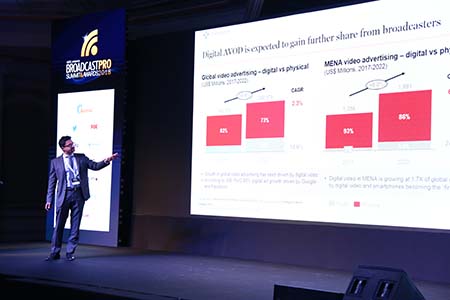Offering a MENA market analysis with a global context, the report titled: Entertainment and Media Outlook Middle East, was launched exclusively at the ASBU BroadcastPro Summit.

Offering a MENA market analysis with a global context, the report titled: Entertainment and Media Outlook Middle East, was launched exclusively at the ASBU BroadcastPro Summit. Presented by Abhijat Sharma, Management Consultant, Entertainment and Media (E&M) at Strategy&, the report spans 53 countries and 15 E&M segments ranging from traditional TV to cinema and OTT.
Sharma began the presentation with a reassuring note that the global E&M industry is growing at a pace close to its historical rates despite much talked about disruption and economic turbulence. According to the report, nominal revenue growth between 2017 and 2022 is forecast to be 4.4%. This is very much in line with the past, indicated Sharma. But as you dive into each of the segments, you see a rather different picture emerge, he added.
In MENA, the report indicates that Saudi Arabia will be the growth and value driver with India, China and Indonesia positioned as drivers of global growth. More specifically, the authors of the report believe, as do most industry observers, that Saudi Arabias support of its creative sectors under Vision 2030 will change the dynamics of the entertainment and media sector in the region.
The MENA region, according to the report, still trails global markets in terms of share of digital revenue, partly due to the wide variance in the enabling infrastructure. That said, in key markets like Saudi Arabia, smartphone data consumption overtook fixed data consumption around 2015, while in the US, the crossover point was achieved only in 2018, and the same is expected in the UK by 2022. As a result, while MENA digital revenues will only be 38% versus the global estimate of 56.9%, KSA and UAE will reach 47% and 46% share of digital revenues respectively. As value is released from traditional media, MENA is expected to be on an accelerated path to digitisation versus global markets.
Publishers will require new internal capability sets like data analytics, UX, etc. while partnering effectively with other platform players Abhijat Sharma, Management Consultant, Media, Entertainment and Culture (MEC), Strategy& (part of the PwC network)
Underlining the lead the region has taken, Sharma said: MENA digitisation is ahead of international trends, indicating that the audiences are already there waiting to be served.
Indicating the findings of the report, Sharma observed: What is interesting is how consumer paid- and advertising-led revenue streams are positioned in the region going forward.
While the report forecasts that consumer-driven revenue remains the largest share through 2022 globally, MENA like other emerging markets will still be an access- or telco-dominated region. The 2017 figures indicate that internet access as a share of the total E&M spend by region is a whopping 50% in the MEA region.
The CAGR for the E&M segment in MENA for the period 20172022 outperforms global CAGR for internet advertising, OTT video, video games (including esports) and cinema.
As a corollary of digitisation, Sharma observed, traditional print media is shrinking at a faster rate than in the rest of the world. Internet advertising and gaming are expected to emerge as primary contributors to media revenues by 2022.
Interestingly, the market share of the E&M segment in 2022 in the MENA region for video games and esports is predicted to be 14% as compared to a 9% share globally. In contrast, the share of traditional TV and home video revenues is predicted to be 8% in MENA, trailing the global share of 15%. The relative market shares in 2022 clearly indicate the impact of younger, more digital audiences on the media landscape evolution in the region.
Sharma indicated that digitisation poses four monetisation challenges for traditional Middle East media players as they attempt to make the transition. While the high degree of dependence on physical advertising revenues comes to mind readily, the transition of physical dollars to digital cents coupled with publishers limited capabilities to build compelling digital value propositions versus the global digital majors (especially direct-to-consumer) remains elusive. Lastly, the dominance of non-commercial models in the region distorts the commercial value chains and places additional pressures on the profit and loss statements of commercial players.
In light of these challenges, Sharma stated that future business models will be shaped by the three pillars of convergence, connections and trust.
Convergence is being driven by a combination of new sector entrants as well as rapid evolution of new business models where media is a key input. Media convergence is clear to see with TV networks having to compete with telecoms, and digital platforms for live sports rights. Access convergence has come about as lines between wired and wireless providers are increasingly blurred and all types of providers are building or buying fibre and spectrum. Google fiber being a case in point. The unlikely coming together of typical non-media players like Amazon and content behemoths like Walt Disney as producers, distributors and retailers of content is an instance of business model convergence. And lastly, hugely popular franchises such as the NBA are travelling globally driving geographic convergence made easier by a lower cost of scaling resulting from channels being digitised.
Traditional print media is shrinking [in MENA] at a faster rate than the rest of the world. Internet advertising and gaming are expected to emerge as primary contributors to media revenues by 2022 Abhijat Sharma, Management Consultant, Media, Entertainment and Culture (MEC), Strategy& (part of the PwC network)
Content is the fuel for the growth of other high-value sectors, stated Sharma as he demonstrated the statistics to support this claim comparing the combined market cap for the top five companies in three sectors of technology, telecom and media. The combined market cap of the top five companies in technology namely, Apple, Alphabet, Microsoft, Amazon and Facebook, estimated to be $3,828bn, dwarfs the telecom and media sectors valued at $914bn and $445bn respectively. The contention that content is fuelling growth in the technology sector is borne out by events on the ground. Amazon Video, the ecommerce behemoth has partnered with the likes of ATP, the English Premier League, NFL and the US Open. Similar partnerships have underlined the growth stories for Facebook and Google.
With direct-to-consumer OTT initiatives in 2022 slated to grow to 18% of global consumer paid video revenues, the increased involvement of players such as Sky, HBO and Disney among others is an indication that content players have realised the value of direct-to-consumer relationships.
The MENA OTT market is expected to rise from 19% of consumer paid video in the region to 24% in 2022. This growth will be driven by partnerships with traditional distributors such as telcos and pay TV providers that provide consolidated payment solutions. These partnerships will also reduce customer acquisition costs and provide better ARPU to OTT players besides revenue shares and strong consumer relationships (led by superior OTT offerings) to the distributors. To illustrate examples of local content efforts, the report highlights Netflixs first Arabic original series Jinn. BroadcastPro has also reported several partnerships forged by the likes of Starz Play and Shahid among others.
Digital AVOD is expected to gain further share from broadcasters, according to the study, led by digital majors like Facebook and Google as they continue to take a dominant share of growth (globally more than 70% of digital ad growth is driven by Google and Facebook). In MENA, digital video is growing at 1.7 times the global growth driven by smartphones becoming the first screen and also by the rapidly improving mobile broadband offering.
Publishers, Sharma said, will need to develop consumer relationships based on specialised brands and build relevance at scale. This will require them to think of these as connections to be leveraged into new revenue streams not siloed by the current media sector definitions. Sharma gave the example of Crunchyrolls immense success in developing new revenue streams based on their anime heritage and its connections. As was illustrated, developing these streams will involve offering customers high-quality experiences while delivering content that addresses viewer interest and turning high-value audiences to new revenue streams.
MENA region is ahead of international trends [on the digital front], indicating that the audiences are already there waiting to be served Abhijat Sharma, Management Consultant, Media, Entertainment and Culture (MEC), Strategy& (part of the PwC network)
In conclusion, Sharma reiterated the four key forces that will shape the MENA broadcast market. Firstly publishers will need to develop new revenue streams that will potentially leverage direct-to-consumer relationships based on their consumer connections. Needless to say, this will require the ability to forge partnerships that exploit the convergence in play effectively. Publishers will hence require new internal capability sets like data analytics, UX, etc. while partnering effectively with other platform players.
And completing the forces shaping the MENA market is the key factor of trust. Sharma stressed that trust will be vital determinant of the E&M sectors ability to forge connections and succeed in an age of convergence. The report outlines the five vital dimensions of trust that include trustworthiness of content, authenticity of audience, securing return on advertising revenues, customer data security and providing an enduring value to society at large.












































































